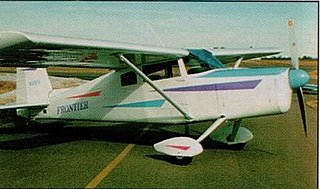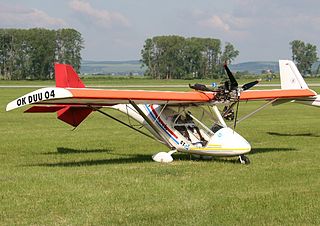The Falconar SAL Mustang, also called the 2/3 Mustang and the SAL P-51D Mustang is a Canadian amateur-built aircraft, originally produced by Falconar Avia and introduced in 1969. The aircraft is a 2⁄3 scale replica of the North American P-51 Mustang and is supplied as a kit or as plans for amateur construction.
The Amax Vixen 105 is an Australian homebuilt aircraft that was designed and produced by Amax Engineering of Donvale, Victoria. When it was available the aircraft was supplied as a kit for amateur construction.
The Duane's Hangar Ultrababy is an American homebuilt aircraft that was designed by Duane Patrick and produced by Duane's Hangar of Liberty, South Carolina, introduced about 1997. When it was available the aircraft was supplied in the form of plans for amateur construction.
The Eurofly Fire Cat is an Italian ultralight aircraft that was designed and produced by Eurofly srl of Galliera Veneta. Now out of production, when it was available the aircraft was supplied as a complete ready-to-fly-aircraft or as a kit for amateur construction.
The Express Series 90 is an American homebuilt aircraft that was designed and produced by the Express Aircraft Company of Olympia, Washington, introduced in the late 1980s. When it was available the aircraft was supplied as a kit for amateur construction.

The Frontier MD-II was an American homebuilt aircraft that was designed and supplied as a kit by Frontier Aircraft Inc of Vail, Colorado, introduced in the 1990s.
The Historical P-51 Mustang is an American homebuilt aircraft that was designed and produced by the Historical Aircraft Corporation of Nucla, Colorado. The aircraft is a 62.5% scale replica of the original North American P-51 Mustang and when it was available was supplied as a kit for amateur construction.
The Historical P-40C Tomahawk is an American homebuilt aircraft that was designed and produced by the Historical Aircraft Corporation of Nucla, Colorado. The aircraft is a 62.5% scale replica of the original Curtiss P-40C Tomahawk and when it was available was supplied as a kit for amateur construction.
The ICP Amigo is an Italian homebuilt aircraft that was designed and produced by ICP srl of Piovà Massaia. When it was available the aircraft was supplied as a kit for amateur construction.
The Junkers Profly Ultima is a German aerobatic homebuilt aircraft that was designed by Andre Konig and produced by Junkers Profly of Kodnitz, introduced in 1993. When it was available the aircraft was supplied as a kit for amateur construction.

The Letov ST-4 Aztek is a Czech microlight aircraft that was designed and produced by Letov Kbely of Prague - Letňany, in the 1990s. When it was available, the aircraft was supplied as a complete ready-to-fly aircraft, or as a kit for amateur construction.
The Mirage Marathon is an American homebuilt aircraft, designed and produced by Mirage Aircraft Corporation of Prescott Valley, Arizona. The aircraft is supplied in the form of plans for amateur construction, with materials kits supplied by Aircraft Spruce & Specialty Co. and Wicks Aircraft Supply as well as some specialized parts supplied by the manufacturer.
The Time Warp Spitfire Mk V is an American homebuilt aircraft that was designed and produced by Time Warp Aircraft of Lakeland, Florida, introduced in 1996 at Sun 'n Fun. When it was available the aircraft was supplied as a kit for amateur construction.
The VSR SR-1 Snoshoo is an American homebuilt Formula One racing aircraft that was designed by Alan VanMeter and A.J. Smith and produced by VanMeter Smith Racing (VSR) of Wichita, Kansas. It was designed in 1993 and first flown in 1997. The aircraft is supplied in the form of plans for amateur construction, with some key parts available to speed construction.
The V-STOL XC 2000T is an American homebuilt and ultralight trainer aircraft that was designed and produced by V-STOL Aircraft of Fort Myers, Florida, introduced in the fall of 1997. When it was available the aircraft was supplied as a kit for amateur construction.
The American Homebuilts John Doe is an American STOL homebuilt aircraft that was designed by Steve Nusbaum and produced by American Homebuilts of Hebron, Illinois, first flown in 1994. When it was available the aircraft was supplied as a kit for amateur construction.
The Spring WS202 Sprint was a Canadian homebuilt aircraft that was designed and produced by William J. Spring of Burlington, Ontario, introduced in 1996. The aircraft was supplied in the form of plans for amateur construction.
The Ibis GS-501 Urraco (Magpie) is a Colombian homebuilt aircraft that was designed and produced by Ibis Aircraft of Cali, introduced in 2000. The aircraft is supplied as a complete ready-to-fly-aircraft or as a kit for amateur construction.
The Ibis GS-750 Grand Magic is a Colombian homebuilt aircraft, designed and produced by Ibis Aircraft of Cali, introduced in 2006. The aircraft is supplied as a complete ready-to-fly-aircraft or as a kit for amateur construction.
The Viper Aircraft Viperfan was an American homebuilt aircraft that was designed and produced by Viper Aircraft of Kennewick, Washington, introduced in the late 1990s. It was intended to be supplied as a kit for amateur construction, but only one was ever built.


